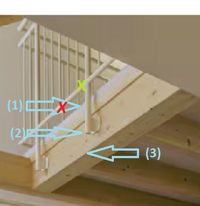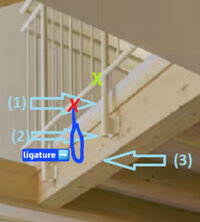S
Suizident
Member
- Aug 7, 2025
- 50
Hello,
the topic of this thread is the basic suitability of (stair) railings as anchor points for full suspension hanging, perhaps also discussed using specific examples/setups.
(Stair) railings can be made of wood or metal. I suspect that metal (stair) railings are more resilient than wooden (stair) railings. There are probably also wooden railings that are very resilient (a wooden ladder isalso very resilient). However, I would imagine that if you are not a carpenter or similar, it is notalways easy to assess how resilient a wooden railing is. For the sake of simplicity, I would therefore say that wooden (stair) railings are out of the question, and only metal railings are of interest.
Special features of a metal railing:
- It is usually made from a single piece. Unlike a wooden railing, this means that it is not possible, for example,for a single railing bar to be pulled out when used as an anchor point.
- Theoretically, the entire railing could be torn out, but I assume that the probabilityis low, as the load should be distributed over several attachment points if the railing is cast in one piece
- I consider it unlikely that any weld seams will break
- A metal railing, possibly painted, is smooth, which means that the rope/knot may slip.
---
Let's take a person of normal weight as an example. I suggest a double constrictor knote as the knot, possibly also an round turn with two half hitches. However, the double constrictor knote may tighten better on the smooth metal railing and therefore slip less. As a safety knot, I suggest a double overhand knot for the loose end.
Below are two pictures (picture 1 = setup 1 and picture 2 = setup2)
PICTURE 1 / SETUP 1

The idea in this fictional example is to attach the rope at the point marked with a green X either with a double constrictor knote (first choice) or with a round turn with two half hitches (second choice). Use a double overhand knot on the loose end as a safety measure.
Evaluation of this setup 1:
- I consider it impossible for the railing to tear apart. I consider it unlikely that a (correct) weld seam will tear.
- The attachment of the railing to the floor should hold. Even if one attachment point should loosen or even tear out, other attachment points should still hold the railing and load (the duration is only a few minutes).
- Theoretically, the knot could slip to the left. But that shouldn't matter. Perhaps it won't slip, as the constrictor knote is very tight. The rope runs past sharp edges: (1) edge of the railing, (2) lower edge of the "railing tube/vertical strut," (3) lower edges of the beam. The edge of the beam is probably (hypothetically) the most dangerous for the rope because the beam is made of wood and is therefore rough, meaning that the edge of the beam can cut the rope most easily. D
- The three "sharp-edged" areas have been marked with a light blue arrow. I suspect that these are not dangerous for the rope in practice. Although the rope may touch a sharp-edged area when swinging back and forth, this should not be enough to cut through the rope.
- In the setup shown in image 1, the distance between the anchor and the floor may not be large enough. In this case, the setup shown in image 2 can be used.
PICTURE 2 / SETUP 2

If the distance between the anchor knot and the floor is not large enough in setup 1, the top crossbar of the railing can be used if necessary (see image 2, the spot marked with a red X).
Evaluation of this setup 2:
- Compared to setup 1, the attachment to the upper crossbar in setup 2 exerts more unfavorable (stronger) lever forces on the railing and the railing attachment. I think the railing and bracket should still hold. After all, the process only takes a few minutes.
- Otherwise, the information provided for setup 1 / image 1 applies.
---
I welcome feedback, especially constructive feedback! :)
Many thanks and best regards,
Suizident
the topic of this thread is the basic suitability of (stair) railings as anchor points for full suspension hanging, perhaps also discussed using specific examples/setups.
(Stair) railings can be made of wood or metal. I suspect that metal (stair) railings are more resilient than wooden (stair) railings. There are probably also wooden railings that are very resilient (a wooden ladder isalso very resilient). However, I would imagine that if you are not a carpenter or similar, it is notalways easy to assess how resilient a wooden railing is. For the sake of simplicity, I would therefore say that wooden (stair) railings are out of the question, and only metal railings are of interest.
Special features of a metal railing:
- It is usually made from a single piece. Unlike a wooden railing, this means that it is not possible, for example,for a single railing bar to be pulled out when used as an anchor point.
- Theoretically, the entire railing could be torn out, but I assume that the probabilityis low, as the load should be distributed over several attachment points if the railing is cast in one piece
- I consider it unlikely that any weld seams will break
- A metal railing, possibly painted, is smooth, which means that the rope/knot may slip.
---
Let's take a person of normal weight as an example. I suggest a double constrictor knote as the knot, possibly also an round turn with two half hitches. However, the double constrictor knote may tighten better on the smooth metal railing and therefore slip less. As a safety knot, I suggest a double overhand knot for the loose end.
Below are two pictures (picture 1 = setup 1 and picture 2 = setup2)
PICTURE 1 / SETUP 1

The idea in this fictional example is to attach the rope at the point marked with a green X either with a double constrictor knote (first choice) or with a round turn with two half hitches (second choice). Use a double overhand knot on the loose end as a safety measure.
Evaluation of this setup 1:
- I consider it impossible for the railing to tear apart. I consider it unlikely that a (correct) weld seam will tear.
- The attachment of the railing to the floor should hold. Even if one attachment point should loosen or even tear out, other attachment points should still hold the railing and load (the duration is only a few minutes).
- Theoretically, the knot could slip to the left. But that shouldn't matter. Perhaps it won't slip, as the constrictor knote is very tight. The rope runs past sharp edges: (1) edge of the railing, (2) lower edge of the "railing tube/vertical strut," (3) lower edges of the beam. The edge of the beam is probably (hypothetically) the most dangerous for the rope because the beam is made of wood and is therefore rough, meaning that the edge of the beam can cut the rope most easily. D
- The three "sharp-edged" areas have been marked with a light blue arrow. I suspect that these are not dangerous for the rope in practice. Although the rope may touch a sharp-edged area when swinging back and forth, this should not be enough to cut through the rope.
- In the setup shown in image 1, the distance between the anchor and the floor may not be large enough. In this case, the setup shown in image 2 can be used.
PICTURE 2 / SETUP 2

If the distance between the anchor knot and the floor is not large enough in setup 1, the top crossbar of the railing can be used if necessary (see image 2, the spot marked with a red X).
Evaluation of this setup 2:
- Compared to setup 1, the attachment to the upper crossbar in setup 2 exerts more unfavorable (stronger) lever forces on the railing and the railing attachment. I think the railing and bracket should still hold. After all, the process only takes a few minutes.
- Otherwise, the information provided for setup 1 / image 1 applies.
---
I welcome feedback, especially constructive feedback! :)
Many thanks and best regards,
Suizident
Last edited:


